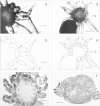Morphological and anatomical changes related to leg anomalies in Tegenaria atrica
- PMID: 25995535
- PMCID: PMC4430592
- DOI: 10.1007/s00435-015-0260-0
Morphological and anatomical changes related to leg anomalies in Tegenaria atrica
Abstract
A range of leg anomalies was detected in embryos of the Tegenaria atrica spiders exposed to alternating temperatures of 14 and 32 °C. Multiple anomalies were observed in 13 individuals. This study is based on five individuals: two individuals affected by oligomely combined, respectively, with heterosymely and polymely, one affected by polymely with heterosymely, one by complicated polymely (accompanied by the reduction in length and malformations of the distal parts of the legs), and one individual with pure polymely. Changes in the central nervous system of these five individuals were described in detail on the basis of histological sections. The changes were mainly related to the number of neuromeres. Individuals affected by polymely had additional ganglia corresponding to the number of additional appendages, whereas the absence of a leg (oligomely) was associated with the absence of a ganglion. Histological analysis showed the fusion of ganglia in the three polymelic specimens, even though additional appendages were not fused.
Keywords: Central nervous system; Malformations; Spider; Teratogenic factor.
Figures



References
-
- Anderson JF. A gynandromorph crab spider. Bull Brooklyn ent soc. 1961;56:100–103.
-
- Asiain J, Márquez J. New teratological examples in neotropical Staphylinidae (Insecta: Coleoptera), with a compilation of previous teratological records. Rev Mex Biodivers. 2009;80:129–139.
-
- Babu KS. Anatomy of central nervous system of Arachnids. Zool Jb Anat. 1965;82:1–154.
-
- Babu KS. Certain histological and anatomical features of central nervous system of a large Indian spider, Poecilotheria. Am Zool. 1969;9:113–119. - PubMed
LinkOut - more resources
Full Text Sources
Other Literature Sources
